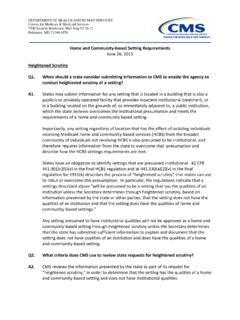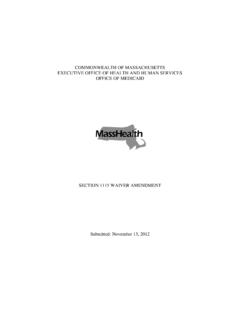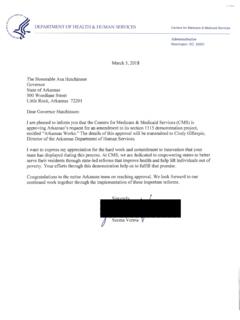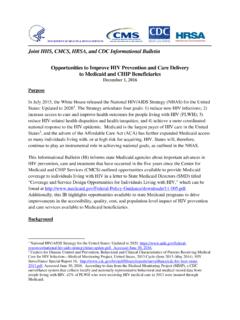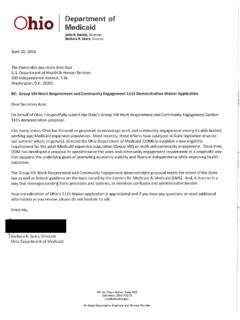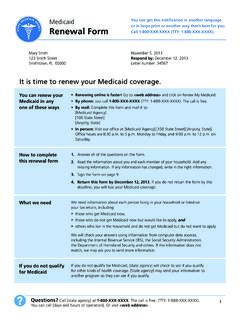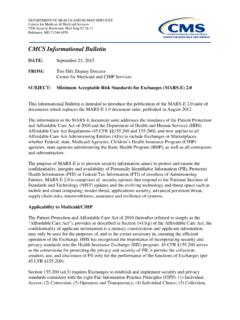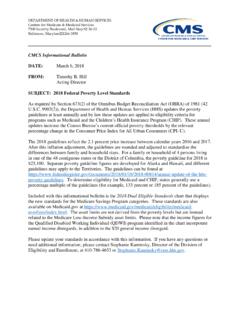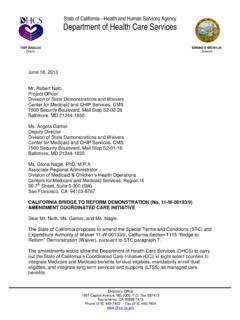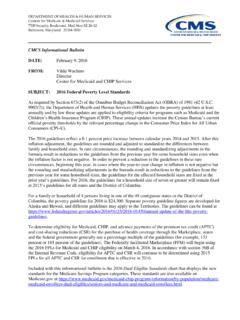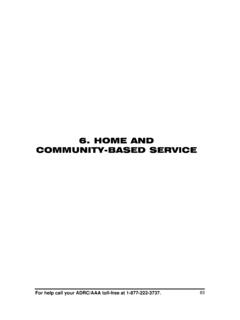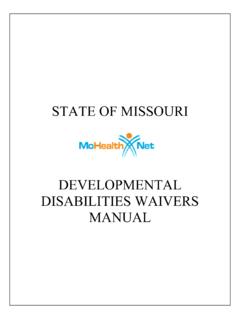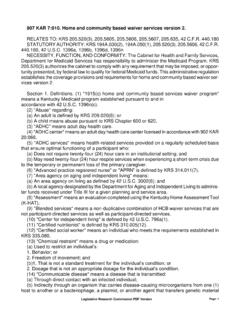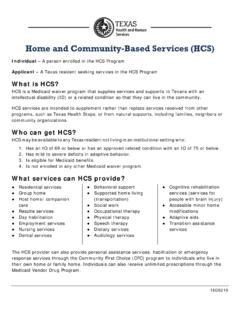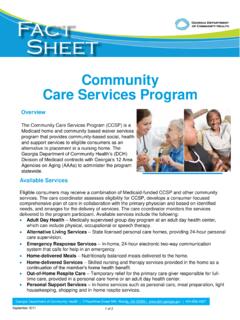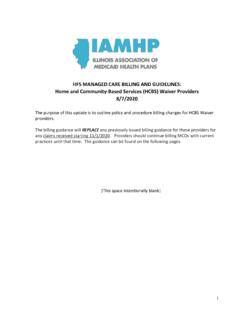Transcription of Appendix K Instructions - Medicaid
1 1915(c) home and community - based services waiver Instructions and Technical Guidance Appendix K: Emergency Preparedness and Response Brief Overview This Appendix was developed as a standalone Appendix to be utilized by the state during emergency situations. It should be used by the state to advise CMS of expected changes to its waiver operations or to request amendment to its approved waiver . It includes actions that states can take under the existing Section 1915(c) home and community - based services (HCBS) waiver authority in order to respond to an emergency. This Appendix may be completed retroactively, as needed, by the state, in accordance with the timeframes set forth in the Section entitled Policies Concerning Amendment in the Instructions and Technical Guide for 1915(c) HCBS waivers.
2 In the event that the state is making permanent changes to the structure and operation of their waiver , the changes reflected in this Appendix should be also included in the appropriate appendices throughout the existing waiver document. CMS has created this Appendix in order to reduce the administrative burden during times of emergencies. In addition, CMS is committed to being responsive and sensitive to the pressures and timeframes that the state is operating under, and we will prioritize such amendments for review. Numerous changes that the state may want to make necessitate authority outside the scope of the 1915(c) authority. States interested in changes to administrative claiming or changes that require 1115 or 1135 authority should engage their CMS Regional Office in a discussion as soon as possible.
3 Some examples may include: (a) changes to administrative activities, such as the establishment of a hotline; (b) suspension of general Medicaid rules that are not addressed in 1915(c), such as payment rules, eligibility rules or suspension of provisions of 1902(a) to which 1915(c) is typically bound. The state may not make changes to the waiver for a waiver year that has already expired or include any changes not allowed under statute, such as the inclusion of room and board costs. CMS encourages states to begin preparations to ensure that acute and primary medical resources are available to meet the needs of individuals served through HCBS. CMS offers this Appendix in the hopes that it will provide a streamlined approach for amendments to 1915(c) waivers when emergencies arise.
4 It should not, however, supplant the state s comprehensive plan for emergency preparedness. There are numerous resources available to states to assist them in developing broad based strategies for addressing emergencies. A few helpful links are noted below, but CMS encourages states to work in close cooperation with their state emergency preparedness resources, as well. Link to the Federal Emergency Management Agency Resources Website Link to Link to Federal Disability Resources Emergency Preparedness Website Link to Centers for Disease Control and Prevention Emergency Preparedness Website Link to National Institutes of Health Disaster Preparation and Recovery Website Link to US Food and Drug Administration Emergency Preparedness Website Link to US Department of Health & Human services Emergency Preparedness Website As a part of the State s overall preparations for emergency situations, CMS encourages states to engage individuals and families in these efforts.
5 Assisting individuals to prepare for emergency situations can be a key to successful system-wide contingency planning. For individuals in the waiver , this effort should begin during the person-centered planning process (and described in the approved waiver document). However, these efforts should further include training and information for individuals and the people that support them to provide them with the information and resources necessary to begin individualized contingency plans, and to arm them with the tools to ensure that their back-up plans are current. Appendix K should be submitted for each affected waiver . Appendix K is currently in Word version only so the state should submit Appendix K to the CMS RO SPA/ waiver Mailbox. Please note that temporary additional services shall be reflected in the 372 form.
6 Added services , costs, and utilization changes would be included for the waiver year affected. Added capacity should also be reflected in the 372 form. Things to Consider Please keep in mind that Fair Hearing Rights under the provisions of 42 CFR 431, Subpart E may apply. Please review the CMS technical guidance provided in Appendix F of the HCBS waiver Technical Guide for information regarding fair hearings. If operated with a concurrent 1915 (b) waiver , the state may need to request commensurate modifications to their 1915(b) waiver . Requirements: Emergency Preparedness and Response Detailed Instructions for Completing Appendix K Item K-1: General Information Item 1-A: State Instructions Enter the state name. Item 1-B: waiver Title Instructions If the waiver has a title ( , Innovations waiver ), enter the title.
7 Otherwise, leave blank. Item 1-C: Control Number Instructions List the waiver number. The waiver number should be the next sequenced amendment number. For example, waiver number would become Item 1-D: Type of Emergency Instructions Indicate the type of emergency. If the type of emergency is not listed, specify the type of emergency under the other category. The state may check more than one box. If the state has multiple emergencies affecting different geographical areas and requiring different changes by type of emergency, the state should break out the information by type of emergency in the appropriate sections. Item 1-E: Brief Description of Emergency Instructions Briefly describe the 1) nature of emergency; 2) number of individuals affected and the state s mechanism to identify individuals at risk; 3) roles of state, local and other entities involved in approved waiver operations; and 4) expected changes needed to the service delivery methods, if applicable.
8 The state should provide this information for each emergency checked in K-1- D above if different geographical areas are affected and if different modifications in waiver operations are needed. Item 1-F: Proposed Effective Date Instructions Enter the proposed effective start date of the amendment. The proposed effective start date is the date that the amendment would take effect. Enter the anticipated end date of the amendment. The end date is the last day that the changes would be in effect. A state may propose that an amendment take effect prospectively on some future date. An amendment also may be made retroactive to the first day of the waiver year (or another date after the first day of the waiver year) in which the amendment is submitted unless the amendment would result in a reduction of the number of persons served, services provided or providers.
9 In these circumstances, amendments may only take effect on or after the date when the amendment is approved by CMS. For additional detail, please see the CMS HCBS waiver Technical Guide, Policies Concerning waiver Amendments and Item (Proposed Effective Date) for information regarding effective dates and the section on Policies Concerning waiver Amendments . If the state seeks to modify its originally proposed effective dates/time span for the use of this Appendix , the state can simply transmit a revised K-1 (submitted through the SPA/ waiver Mailbox for your respective Regional Office). Item 1-G: Transition Plan Instructions Some of the temporary modifications that states make ( , modifying targeting criteria, adding or modifying services , increasing factor C, increasing individual cost limits, etc.)
10 May result in individuals being temporarily enrolled in the waiver , or temporarily accessing additional services . A transition plan is necessary for waiver participants who might be adversely affected when the temporary changes cease and the waiver reverts back to its original form. Please see the Transition Plan Section of the CMS HCBS waiver Technical Guide for additional guidance or information regarding transition plans. Please note that all applicable Fair Hearing rights apply. Item 1-H: Geographic Areas Affected Instructions Specify the geographic areas affected by the emergency. For example, the state may use geographic areas such as counties, cities, state planning regions or human catchment areas, or political subdivisions such as counties or municipalities of the state.
